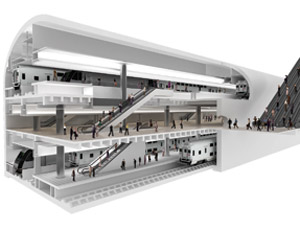State departments of transportation have been hit with a double whammy in recent years. In lieu of a long-term federal surface transportation reauthorization bill, the federal government continues to dole out money through Highway Trust Fund extensions, making it difficult for DOTs to plan for the future. At the same time, the recession has tightened the screws on state coffers, leaving some to wonder if significant capacity work is even possible in the coming years.

For much of the year, DOTs have based near-term federal funding availability on a Highway Trust Fund extension that expires at the end of 2010.
On Labor Day, President Obama outlined a set of infrastructure principles that call for $50 billion in “up-front investment in our nation’s infrastructure.” Among the goals of the plan are rebuilding 150,000 miles of roads, constructing 4,000 miles of rail and rehabilitating or reconstructing 150 miles of runway.
However, detailed specifics remain unclear. Jack Basso, director of program finance and management at the American Association of State Highway and Transportation Officials, says the proposed funding could be based on the previous model under the American Recovery and Reinvestment Act, which focused on “ready to go” projects. It also could be the seed of the next reauthorization bill, he adds. “The [announcement] talks about front-end-loading $50 billion, but we don’t know what that means,” he says. “We would like to translate it into ready-to-go stuff, but no one has said that.”
Cautious Times
With the elections in November, followed by a lame-duck session through the end of the year, many on the Hill remain skeptical that there will be significant progress on reauthorization until next year.
Looming uncertainty about reauthorization has created a fuzzy outlook of the future for DOTs. Pennsylvania is in the midst of updating it four-year transportation improvement plan, and Secretary of Transportation Allen Biehler says the state will have to err on the side of caution.
“We have to be fiscally restrained and make projections about what’s coming, not only from the state coffers but the federal coffers,” he says. “What do we do planning-wise? Sitting without USDOT representatives, we have no ability to say anything other than ‘We hope it will be at least what we have now.’ ”
Although the state saw a 4.5% reduction in 2009 bid prices, that drop followed an 80% escalation in costs during the previous five years. “We’ve gotten so undermined by a lack of monies that [would allow us to] keep pace with inflation,” he adds. “We’re really behind the eight ball just to maintain our system.”
Biehler says the continued demands on maintenance will choke funds for system expansions.
When Biehler took office in 2003, he says 25% of the state’s program was dedicated to expansion. Today, the most recent plan the state submitted for federal approval carries only a 3.7% capacity increase.
Dire Measures
The funding crunch has caused many states to take a hard look at revenues. In September, budget concerns prompted New Jersey Transit Executive Director James Weinstein to impose a 30-day suspension on the $8.7-billion ARC Trans-Hudson Express Tunnel project between New Jersey and Manhattan. That same month, Weinstein told the New Jersey Assembly Transportation and Public Works Committee the state was considering redirecting $2.2 billion from the project to help bolster the state’s Transportation Trust Fund. A few weeks later, Gov. Chris Christie (R) cancelled the construction project, already under construction (see related article, p. 62).
In October 2009, Arizona had to shut down several of its rest areas to keep from draining funds away from state road maintenance priorities. The state has since moved to stabilize its budgets and reopen rest areas as possible, but ADOT director John Halikowski says the future revenues could be hampered without a fix to the federal Highway Trust Fund.
“The [state’s] current five-year plan is in place, and we’re OK as far as what is on the boards, provided that we don’t see a meltdown,” he says.
“But when you talk about capacity needs, what’s coming into the Highway Trust Fund isn’t going to cut that. The question is, with increased fuel economy and gas taxes remaining flat, what will we do to meet those needs?” he says.
Despite the tough economic environment, some DOTs are seeing successful efforts to grow their programs. The Virginia Dept. of Transportation is accelerating project awards after an independent audit in September found that $877 million in funds had been left unspent during the last two fiscal years.
Reversal of Fortune
The added funding marks a reversal for Virginia. Since 2009, the state had cut approximately $2.8 billion from the state’s six-year improvement program, which covers essential highway, rail, transit, bicycle and pedestrian projects from fiscal 2011 through 2016.
The plan includes $5.7 billion for highway construction and $2.1 billion for rail and public transportation.
In Kansas, voters approved a sales tax increase that, in part, will help fund future transportation needs. Starting in 2013, a 0.4% increase in state sales taxes will add $1.4 billion to the state’s 10-year transportation plan. Currently, the plan calls for $4.626 billion for highway preservation and $1.7 billion for expansion and modernization.
Kansas Dept. of Transportation Secretary Deb Miller says, “$1.7 billion over 10 years is far from sufficient, but we believe if we’re mindful and make good solid strategic decisions that—while we won’t fund everything—we’ll fund things that make sense for Kansas. We’ll get good benefits from it.”

Post a comment to this article
Report Abusive Comment